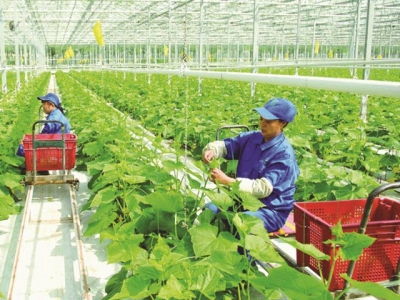Economic restructuring: Slow and uncertain

The slow and uncertain economic restructuring is a great concern, which may affect the growth of our economy in the long term.
It is necessary to focus on developing a strong and efficient private economic sector. Photo: ST.
Positive signs
The report on "Evaluating the results of restructuring the economy and renewing the growth model for the 2016-2020 period" by the Central Institute for Economic Management (CIEM) said that the programs on economic restructuring aim at three strategic points. The first is investment restructuring, helping social investment to achieve the set goals and increasing private investment, but until now, the investment structure has not been uniform – investment has mainly focused on the processing and manufacturing industry, transportation and warehousing, while investment in some areas such as banking and finance, insurance has declined. The second is the restructuring of the financial market, the problem of cross-ownership has been solved, reducing from 56 pairs of cross-ownership in 2012 to only 1 pair; the handling of weak commercial banks has also been actively implemented, the capital adequacy ratio of banks has been improved at an average of 12.08 percent; bad debts are handled more effectively. The third is the restructuring of state-owned enterprises, but the quantity and quality of enterprises implementing equitisation and divestment is much slower than the targets.
Commenting on the above issues, PhD. Nguyen Dinh Cung, former director of CIEM, said the process of economic restructuring has made certain improvements in the manner and quality of growth. The growth has mainly been based on reform and promotion of business and production instead of expanding credit and stimulus packages like 2006-2010, and investment efficiency increased significantly. Moreover, the overall economic structure has changed positively, especially the state economic sector has plummeted, the private economy has prospered when some private economic groups have transformed from real-estate business into multi-sector business, that consider industry, technology and service quality as the focus.
Nguyen Minh Cuong, principal country economist at the Asian Development Bank (ADB), said the bright spot in Vietnam's economic growth is sustainable growth of domestic demand. In particular, domestic companies have also made stronger contribution to the country’s export value, if this is an upward trend, it will be a positive sign, showing that Vietnam is strongly shifting from dependence on the foreign sector to the domestic sector.
“Gaps” and vulnerability
Despite these positive results, CIEM's report stated that the economic structure is still less dynamic, the shifting is less healthy, less balanced and more vulnerable. Because the domestic private economic sector is too small, growth is not fast enough to confirm its role. While the foreign investment sector still accounts for a large amount of resources, accounting for one fifth of GDP, one quarter of total social investment and the whole trade surplus. This will create division among economic sectors, leading to a lack of interaction and support to create a unified economy. In general, restructuring programs are being conducted more slowly than required.
Also commenting on the changes in the economic restructuring Bui Tat Thang, former Director of the Institute of Development Strategy (Ministry of Planning and Investment) said that despite experiencing 35 years of changing the market economy with a lot of institutional reforms, the quality of the market economy institutions is still low and uniform in sectors and fields; the market is not really a basis for mobilizing and allocating development resources. Moreover, restructuring the economy and renewing the growth model have done many things and achieved many results but attaching to the growth model has not clear and a new growth model based on increasing labour productivity, high technology level and production techniques has not been established.
Obviously, our country's economy still has "gaps" and has not had strong growth to respond to external impacts, especially in the current context when trade wars and political conflicts of countries around the world may have a great impact on the domestic economy. Cung said the root cause of this slow and uncertain restructuring is failure in the change of thinking – we are not determined to change a market economy. Consequently, the direction and administration are inconsistent and inappropriate. "We hang around with unclear concepts, are unable to change the thinking and awareness of the role of state-owned enterprises and the role of the private economy, thereby benefiting the FDI sector," Cung said
Therefore, the economists recommended that Vietnam needs to continue to promote the economic restructuring, shaping a new economic growth model. Economist Can Van Luc said that it is necessary to carefully evaluate the results of socio-economic development in the past 10 years to identify problems to overcome in the future. For the period 2021-2030, public agencies need to create a relationship among three factors: sustainable development, innovation and inclusiveness because we often confuse these criteria.
Besides, economists also said that Vietnam needs to have solutions to overcome the imbalance of the economy, making the domestic private sector develop faster and more uniformly, making State-owned enterprises more autonomous and more dynamic according to market rules. But in order for the economy to be dynamic in a dynamic state, it requires the leading and motivating role of the State, so it must perform properly and effectively as a facilitating State.
Có thể bạn quan tâm
Phần mềm

Phối trộn thức ăn chăn nuôi

Pha dung dịch thủy canh

Định mức cho tôm ăn

Phối trộn phân bón NPK

Xác định tỷ lệ tôm sống

Chuyển đổi đơn vị phân bón

Xác định công suất sục khí

Chuyển đổi đơn vị tôm

Tính diện tích nhà kính

Tính thể tích ao hồ



 Land policies restrain Việt Nam agricultural development
Land policies restrain Việt Nam agricultural development  Farmers in Mekong delta earn more thanks to…
Farmers in Mekong delta earn more thanks to…